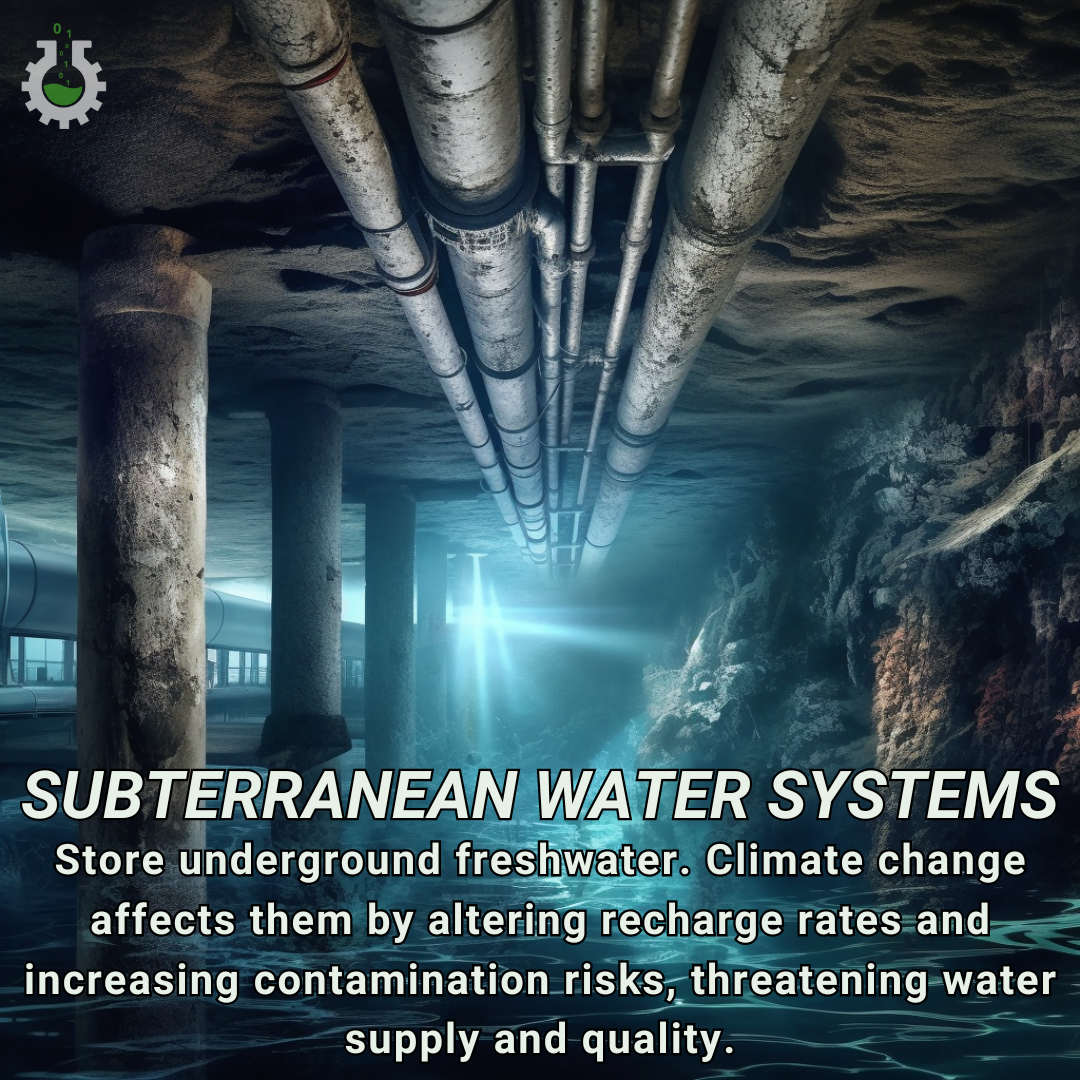June 12, 2024
Climate Change Poster Collection of the Day – Subterranean Water Systems
Book a Demo
Today’s Climate Change Poster Collection highlights Subterranean Water Systems, commonly referred to as groundwater systems, are the vast networks of water that reside beneath the Earth’s surface in soil pore spaces and fractures of rock formations. These hidden reservoirs play a crucial role in the global water cycle, supplying around 30% of the world’s freshwater resources and serving as a lifeline for agriculture, industry, and domestic use. Groundwater systems are recharged through precipitation that infiltrates the ground, making its way down to aquifers, which are geological formations capable of storing and transmitting water. However, the delicate balance of these subterranean ecosystems is increasingly under threat from the multifaceted impacts of climate change, which is altering precipitation patterns, increasing temperatures, and driving sea-level rise.
One of the most direct ways climate change affects groundwater systems is through changes in precipitation patterns. As climate change intensifies, many regions are experiencing more extreme weather events, including prolonged droughts and intense rainfall. This variability disrupts the natural recharge processes of aquifers. In areas facing decreased precipitation, the rate at which groundwater is replenished diminishes, leading to lower water tables and reduced availability of this critical resource. Conversely, intense rainfall events can lead to rapid runoff, reducing the amount of water that infiltrates the ground and recharges aquifers. Thus, the stability of groundwater systems is compromised, affecting water availability for agriculture and human consumption.
Rising temperatures also play a significant role in influencing groundwater systems. Higher temperatures increase the rate of evaporation from soil and surface water bodies, reducing the amount of water that can percolate down to recharge aquifers. Additionally, warmer temperatures elevate water demand for irrigation, industrial processes, and domestic use, putting further stress on already strained groundwater resources. In regions where groundwater is the primary source of water, this increased demand can lead to over-extraction, causing a decline in water quality and quantity, and potentially leading to land subsidence.
Sea-level rise, another consequence of climate change, poses a grave threat to coastal aquifers. As sea levels rise, saltwater can intrude into freshwater aquifers, contaminating them with salt and rendering the water unsuitable for drinking and irrigation. This saltwater intrusion not only diminishes the availability of freshwater but also disrupts the delicate balance of coastal ecosystems that rely on the interplay between fresh and saltwater.
Moreover, the melting of glaciers and ice caps, driven by global warming, has a dual impact on groundwater systems. In the short term, increased meltwater can temporarily boost groundwater levels in regions that rely on glacial runoff for recharge. However, as glaciers continue to shrink, this source of recharge will diminish, leading to long-term reductions in groundwater availability. This is particularly concerning for communities and ecosystems that depend on consistent glacial meltwater for their water supply.
The impact of climate change on subterranean water systems extends beyond quantity to quality and ecosystem health. Changes in groundwater levels and flow patterns can affect the chemical composition of the water, potentially leading to increased nutrient loading and contamination. Subterranean ecosystems, including cave-dwelling species and microorganisms, are highly adapted to stable conditions and are particularly vulnerable to these changes. Alterations in groundwater quality and quantity can disrupt these ecosystems, leading to biodiversity loss and the degradation of unique subterranean habitats.
In addition to these direct impacts, subterranean water systems are also involved in feedback loops that can exacerbate climate change. Wetlands and peatlands, which are often sustained by groundwater, play a significant role in carbon sequestration. Changes in groundwater levels can affect the ability of these systems to store carbon, potentially releasing stored carbon into the atmosphere and contributing to further climate change.
Addressing the challenges posed by climate change to subterranean water systems requires a multifaceted approach. Sustainable groundwater management practices, such as controlled extraction and artificial recharge, are essential to maintain the balance between water use and recharge. Enhanced monitoring of groundwater levels and quality, coupled with research into the impacts of climate change on these systems, is crucial for developing effective adaptation strategies. Strong regulatory frameworks are needed to protect groundwater resources from over-extraction and contamination, ensuring their availability for future generations.
Subterranean water systems are a hidden yet vital component of the global water cycle, and their health is intricately linked to the impacts of climate change. As we continue to navigate the challenges posed by a changing climate, understanding and protecting these underground reservoirs will be essential for ensuring water security, ecosystem health, and sustainable development.
Discover an inspiring collection of climate change poster.



